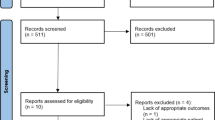Abstract
Objective
To compare the outcome of biliary atresia (BA) patients with and without hilar cyst on preoperative ultrasound.
Methods
A single center retrospective review of patients of BA with (n = 27) and without hilar cyst (n = 27) over a 5 y period was done. The patients were analyzed using propensity score matching to reduce selection bias. All patients were diagnosed as type III BA by histologic examination and cholangiograms. Clinicopathological characteristics and survival outcomes were compared between the two groups.
Results
There were no significant intergroup differences between baseline characteristics and outcomes after Kasai portoenterostomy surgery in two groups. BA with hilar cyst group showed comparable survival outcomes to the BA without cyst group (cumulative 1-y, 2-y and 5-y overall survival rates with native liver 61.4% vs. 65.8%, P = 0.041; 45.0% vs. 49.0%, P = 0.57; 45.0% vs. 49.0%, P = 0.57). And the Kaplan–Meier survival curves showed no significant difference in cumulative survival with native liver between the two groups (P = 0.58).
Conclusions
Type III BA with hilar cyst had no better prognosis compared with Type III BA without cyst.



Similar content being viewed by others
References
Hartley JL, Davenport M, Kelly DA. Biliary atresia. Lancet. 2009;374:1704–13.
Superina R, Magee JC, Brandt ML, et al. The anatomic pattern of biliary atresia identified at time of Kasai hepatoportoenterostomy and early postoperative clearance of jaundice are significant predictors of transplant-free survival. Ann Surg. 2011;254:577–85.
Arima E, Fonkalsrud EW, Neerhout RC. Experience in the management of surgically correctable biliary atresia. Surgery. 1974;75:228–32.
Lilly JR, Hall RJ, Vasquez-Estevez J, Karrer F, Shikes RH. The surgery of "correctable" biliary atresia. J Pediatric Surg. 1987;22:522–5.
Karrer FM, Lilly JR, Stewart BA, Hall RJ. Biliary atresia registry, 1976 to 1989. J Pediatric Surg. 1990;25:1076–80 discussion 1081.
Koob M, Pariente D, Habes D, Ducot B, Adamsbaum C, Franchi-Abella S. The porta hepatis microcyst: an additional sonographic sign for the diagnosis of biliary atresia. Eur Radiol. 2017;27:1812–21.
Kim MJ, Park YN, Han SJ, et al. Biliary atresia in neonates and infants: triangular area of high signal intensity in the porta hepatis at T2-weighted MR cholangiography with US and histopathologic correlation. Radiology. 2000;215:395–401.
Caponcelli E, Knisely AS, Davenport M. Cystic biliary atresia: an etiologic and prognostic subgroup. J Pediatric Surg. 2008;43:1619–24.
Lal R, Prasad DK, Krishna P, et al. Biliary atresia with a "cyst at porta": management and outcome as per the cholangiographic anatomy. Pediatr Surg Int. 2007;23:773–8.
Hill SJ, Clifton MS, Derderian SC, Wulkan ML, Ricketts RR. Cystic biliary atresia: a wolf in sheep's clothing. Am Surg. 2013;79:870–2.
Zhou LY, Chen SL, Chen HD, et al. Percutaneous US-guided cholecystocholangiography with microbubbles for assessment of infants with US findings equivocal for biliary atresia and gallbladder longer than 1.5 cm: a pilot study. Radiology. 2018;286:1033–9.
Chen S, Liao B, Zhong Z, et al. Supersonic shearwave elastography in the assessment of liver fibrosis for postoperative patients with biliary atresia. Sci Rep. 2016;6:31057.
Nio M, Ohi R, Miyano T, Saeki M, Shiraki K, Tanaka K. Five- and 10-year survival rates after surgery for biliary atresia: a report from the Japanese biliary atresia registry. J Pediatric Surg. 2003;38:997–1000.
Kasahara M, Umeshita K, Sakamoto S, Fukuda A, Furukawa H, Uemoto S. Liver transplantation for biliary atresia: a systematic review. Pediatr Surg Int. 2017;33:1289–95.
Ohi R, Nio M, Chiba T, et al. The present status and problems in the treatment of biliary atresia with special reference to surgical and long-term results. Nihon Geka Gakkai Zasshi. 1989;90:1339–42.
Deguchi E, Iwai N, Yanagihara J, Shimotake T. Relationship between intraoperative cholangiographic patterns and outcomes in biliary atresia. Eur J Pediatr Surg. 1998;8:146–9.
Shin NY, Kim MJ, Lee MJ, et al. Transient elastography and sonography for prediction of liver fibrosis in infants with biliary atresia. J Ultrasound Med. 2014;33:853–64.
Wu JF, Lee CS, Lin WH, et al. Transient elastography is useful in diagnosing biliary atresia and predicting prognosis after hepatoportoenterostomy. Hepatology. 2018;68:616–24.
Funding
This study was funded by National Natural Science Foundation of China (NO: 81501480 & NO: 81530055) and Natural Science Foundation of Guangdong province (NO: 2015A030313060).
Author information
Authors and Affiliations
Corresponding authors
Ethics declarations
Ethical Approval
All procedures performed in studies involving human participants were in accordance with the ethical standards of the institutional and national research committee and with the 1964 Helsinki declaration and its later amendments or comparable ethical standards.
Conflict of Interest
None.
Informed Consent
Informed consent was obtained from all individual participants included in the study.
Additional information
Publisher’s Note
Springer Nature remains neutral with regard to jurisdictional claims in published maps and institutional affiliations.
Rights and permissions
About this article
Cite this article
Shan, Qy., Liu, Bx., Zhong, Zh. et al. The Prognosis of Type III Biliary Atresia with Hilar Cyst. Indian J Pediatr 88, 650–655 (2021). https://doi.org/10.1007/s12098-020-03561-z
Received:
Accepted:
Published:
Issue Date:
DOI: https://doi.org/10.1007/s12098-020-03561-z




